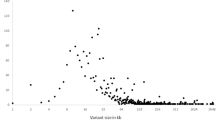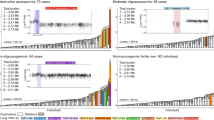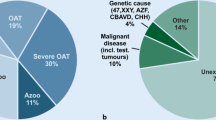Abstract
Globozoospermia is a rare phenotype of primary male infertility inducing the production of round-headed spermatozoa without acrosome. Anomalies of DPY19L2 account for 50–70% of all cases and the entire deletion of the gene is by far the most frequent defect identified. Here, we present a large cohort of 69 patients with 20–100% of globozoospermia. Genetic analyses including multiplex ligation-dependent probe amplification, Sanger sequencing and whole-exome sequencing identified 25 subjects with a homozygous DPY19L2 deletion (36%) and 14 carrying other DPY19L2 defects (20%). Overall, 11 deleterious single-nucleotide variants were identified including eight novel and three already published mutations. Patients with a higher rate of round-headed spermatozoa were more often diagnosed and had a higher proportion of loss of function anomalies, highlighting a good genotype phenotype correlation. No gene defects were identified in patients carrying < 50% of globozoospermia while diagnosis efficiency rose to 77% for patients with > 50% of globozoospermia. In addition, results from whole-exome sequencing were scrutinized for 23 patients with a DPY19L2 negative diagnosis, searching for deleterious variants in the nine other genes described to be associated with globozoospermia in human (C2CD6, C7orf61, CCDC62, CCIN, DNAH17, GGN, PICK1, SPATA16, and ZPBP1). Only one homozygous novel truncating variant was identified in the GGN gene in one patient, confirming the association of GGN with globozoospermia. In view of these results, we propose a novel diagnostic strategy focusing on patients with at least 50% of globozoospermia and based on a classical qualitative PCR to detect DPY19L2 homozygous deletions. In the absence of the latter, we recommend to perform whole-exome sequencing to search for defects in DPY19L2 as well as in the other previously described candidate genes.
Similar content being viewed by others
References
Adzhubei IA, Schmidt S, Peshkin L et al (2010) A method and server for predicting damaging missense mutations. Nat Methods 7:248–249. https://doi.org/10.1038/nmeth0410-248
Alimohammadi F, Ebrahimi Nasab M, Rafaee A et al (2020) Deletion of dpy-19 like 2 (DPY19L2) gene is associated with total but not partial globozoospermia. Reprod Fertil Dev. https://doi.org/10.1071/RD19025
Anton-Lamprecht I, Kotzur B, Schopf E (1976) Round-headed human spermatozoa. Fertil Steril 27:685–693. https://doi.org/10.1016/s0015-0282(16)41900-x
Buettner FFR, Ashikov A, Tiemann B et al (2013) C. elegans DPY-19 is a C-mannosyltransferase glycosylating thrombospondin repeats. Mol Cell 50:295–302. https://doi.org/10.1016/j.molcel.2013.03.003
Chemes HE (2018) Phenotypic varieties of sperm pathology: genetic abnormalities or environmental influences can result in different patterns of abnormal spermatozoa. Anim Reprod Sci 194:41–56. https://doi.org/10.1016/j.anireprosci.2018.04.074
Chen S, Zhou Y, Chen Y, Gu J (2018) Fastp: an ultra-fast all-in-one FASTQ preprocessor. Bioinformatics 34:i884–i890. https://doi.org/10.1093/bioinformatics/bty560
Chianese C, Fino MG, Riera Escamilla A et al (2015) Comprehensive investigation in patients affected by sperm macrocephaly and globozoospermia. Andrology 3:203–212. https://doi.org/10.1111/andr.12016
Cooper TG, Noonan E, von Eckardstein S et al (2010) World Health Organization reference values for human semen characteristics*‡. Hum Reprod Update 16:231–245. https://doi.org/10.1093/humupd/dmp048
Coutton C, Vieville G, Satre V et al (2012a) Multiplex ligation-dependent probe amplification (MLPA) et sondes « à façon » entièrement synthétiques. Guide pratique, recommandations et expérience au CHU de Grenoble. IRBM 33:227–235. https://doi.org/10.1016/j.irbm.2012.04.004
Coutton C, Zouari R, Abada F et al (2012b) MLPA and sequence analysis of DPY19L2 reveals point mutations causing globozoospermia. Hum Reprod 27:2549–2558. https://doi.org/10.1093/humrep/des160
Coutton C, Abada F, Karaouzene T et al (2013) Fine characterisation of a recombination hotspot at the DPY19L2 locus and resolution of the paradoxical excess of duplications over deletions in the general population. PLoS Genet 9:e1003363. https://doi.org/10.1371/journal.pgen.1003363
Coutton C, Escoffier J, Martinez G et al (2015) Teratozoospermia: spotlight on the main genetic actors in the human. Hum Reprod Update 21:455–485. https://doi.org/10.1093/humupd/dmv020
Dam AHDM, Koscinski I, Kremer JAM et al (2007) Homozygous mutation in SPATA16 is associated with male infertility in human globozoospermia. Am J Hum Genet 81:813–820. https://doi.org/10.1086/521314
Dam AH, Ramos L, Dijkman HB et al (2011) Morphology of partial globozoospermia. J Androl 32:199–206. https://doi.org/10.2164/jandrol.109.009530
Datta J, Palmer MJ, Tanton C et al (2016) Prevalence of infertility and help seeking among 15 000 women and men. Hum Reprod 31:2108–2118. https://doi.org/10.1093/humrep/dew123
den Dunnen JT, Antonarakis SE (2000) Mutation nomenclaturess extensions and suggestions to describe complex mutations: a discussion. Hum Mutat 15:7–12. https://doi.org/10.1002/(SICI)1098-1004(200001)15:1%3c7::AID-HUMU4%3e3.0.CO;2-N
Desmet F-O, Hamroun D, Lalande M et al (2009) Human splicing finder: an online bioinformatics tool to predict splicing signals. Nucleic Acids Res 37:e67. https://doi.org/10.1093/nar/gkp215
Elinati E, Kuentz P, Redin C et al (2012) Globozoospermia is mainly due to DPY19L2 deletion via non-allelic homologous recombination involving two recombination hotspots. Hum Mol Genet 21:3695–3702. https://doi.org/10.1093/hmg/dds200
ElInati E, Fossard C, Okutman O et al (2016) A new mutation identified in SPATA16 in two globozoospermic patients. J Assist Reprod Genet 33:815–820. https://doi.org/10.1007/s10815-016-0715-3
Ghédir H, Ibala-Romdhane S, Okutman O et al (2016) Identification of a new DPY19L2 mutation and a better definition of DPY19L2 deletion breakpoints leading to globozoospermia. Mol Hum Reprod 22:35–45. https://doi.org/10.1093/molehr/gav061
Ghédir H, Braham A, Viville S et al (2019) Comparison of sperm morphology and nuclear sperm quality in SPATA16- and DPY19L2-mutated globozoospermic patients. Andrologia 51:e13277. https://doi.org/10.1111/and.13277
Guan R, Wen X-Y, Wu J et al (2012) Knockdown of ZNF403 inhibits cell proliferation and induces G2/M arrest by modulating cell-cycle mediators. Mol Cell Biochem 365:211–222. https://doi.org/10.1007/s11010-012-1262-6
Han T, Wang L, Tang W et al (2020) GGNBP1 ensures proper spermiogenesis in response to stress in mice. Biochem Biophys Res Commun 525:706–713. https://doi.org/10.1016/j.bbrc.2020.02.118
Harbuz R, Zouari R, Pierre V et al (2011) A recurrent deletion of DPY19L2 causes infertility in man by blocking sperm head elongation and acrosome formation. Am J Hum Genet 88:351–361. https://doi.org/10.1016/j.ajhg.2011.02.007
Jamsai D, Bianco DM, Smith SJ et al (2008) Characterization of gametogenetin 1 (GGN1) and its potential role in male fertility through the interaction with the ion channel regulator, cysteine-rich secretory protein 2 (CRISP2) in the sperm tail. Reproduction 135:751–759. https://doi.org/10.1530/REP-07-0485
Jamsai D, O’Connor AE, DeBoer KD et al (2013) Loss of GGN leads to pre-implantation embryonic lethality and compromised male meiotic DNA double strand break repair in the mouse. PLoS ONE 8:e56955. https://doi.org/10.1371/journal.pone.0056955
Kim S, Scheffler K, Halpern AL et al (2018) Strelka2: fast and accurate calling of germline and somatic variants. Nat Methods 15:591–594. https://doi.org/10.1038/s41592-018-0051-x
Kopanos C, Tsiolkas V, Kouris A et al (2019) VarSome: the human genomic variant search engine. Bioinformatics 35:1978–1980. https://doi.org/10.1093/bioinformatics/bty897
Koscinski I, ElInati E, Fossard C et al (2011) DPY19L2 deletion as a major cause of globozoospermia. Am J Hum Genet 88:344–350. https://doi.org/10.1016/j.ajhg.2011.01.018
Li H (2013) Aligning sequence reads, clone sequences and assembly contigs with BWA-MEM. arXiv:13033997 [q-bio]
Li H, Handsaker B, Wysoker A et al (2009) The sequence alignment/map format and SAMtools. Bioinformatics 25:2078–2079. https://doi.org/10.1093/bioinformatics/btp352
Liu G, Shi Q-W, Lu G-X (2010) A newly discovered mutation in PICK1 in a human with globozoospermia. Asian J Androl 12:556–560. https://doi.org/10.1038/aja.2010.47
Lu B, Bishop CE (2003) Mouse GGN1 and GGN3, two germ cell-specific proteins from the single gene Ggn, interact with mouse POG and play a role in spermatogenesis. J Biol Chem 278:16289–16296. https://doi.org/10.1074/jbc.M211023200
Mascarenhas MN, Flaxman SR, Boerma T et al (2012) National, regional, and global trends in infertility prevalence since 1990: a systematic analysis of 277 health surveys. PLOS Med 9:e1001356. https://doi.org/10.1371/journal.pmed.1001356
McLaren W, Gil L, Hunt SE et al (2016) The ensembl variant effect predictor. Genome Biol 17:122. https://doi.org/10.1186/s13059-016-0974-4
Modarres P, Tanhaei S, Tavalaee M et al (2016) Assessment of DPY19L2 deletion in familial and non-familial individuals with globozoospermia and DPY19L2 genotyping. Int J Fertil Steril 10:196–207
Modarres P, Tavalaee M, Ghaedi K, Nasr-Esfahani MH (2018) An overview of the globozoospermia as a multigenic identified syndrome. IJFS. https://doi.org/10.22074/ijfs.2019.5561
Oud MS, Okutman Ö, Hendricks LAJ et al (2020) Exome sequencing reveals novel causes as well as new candidate genes for human globozoospermia. Hum Reprod 35:240–252. https://doi.org/10.1093/humrep/dez246
Pierre V, Martinez G, Coutton C et al (2012) Absence of Dpy19l2, a new inner nuclear membrane protein, causes globozoospermia in mice by preventing the anchoring of the acrosome to the nucleus. Development 139:2955–2965. https://doi.org/10.1242/dev.077982
Ray PF, Toure A, Metzler-Guillemain C et al (2017) Genetic abnormalities leading to qualitative defects of sperm morphology or function: genetic abnormalities leading to qualitative sperm defects. Clin Genet 91:217–232. https://doi.org/10.1111/cge.12905
Richards S, Aziz N, Bale S et al (2015) Standards and guidelines for the interpretation of sequence variants: a joint consensus recommendation of the American College of Medical Genetics and Genomics and the Association for Molecular Pathology. Genet Med 17:405–423. https://doi.org/10.1038/gim.2015.30
Shang Y-L, Zhu F-X, Yan J et al (2019) Novel DPY19L2 variants in globozoospermic patients and the overcoming this male infertility. Asian J Androl 21:183–189. https://doi.org/10.4103/aja.aja_79_18
Singh G (1992) Ultrastructural features of round-headed human spermatozoa. Int J Fertil 37:99–102
Tokuhiro K, Isotani A, Yokota S et al (2009) OAZ-t/OAZ3 is essential for rigid connection of sperm tails to heads in mouse. PLoS Genet 5:e1000712. https://doi.org/10.1371/journal.pgen.1000712
Touré A, Martinez G, Kherraf Z-E et al (2020) The genetic architecture of morphological abnormalities of the sperm tail. Hum Genet. https://doi.org/10.1007/s00439-020-02113-x
Yatsenko AN, O’Neil DS, Roy A et al (2012) Association of mutations in the zona pellucida binding protein 1 (ZPBP1) gene with abnormal sperm head morphology in infertile men. Mol Hum Reprod 18:14–21. https://doi.org/10.1093/molehr/gar057
Zhang J, Wang Y, Zhou Y et al (2005) Yeast two-hybrid screens imply that GGNBP1, GGNBP2 and OAZ3 are potential interaction partners of testicular germ cell-specific protein GGN1. FEBS Lett 579:559–566. https://doi.org/10.1016/j.febslet.2004.10.112
Zhou Y, Zhao Q, Bishop CE et al (2005) Identification and characterization of a novel testicular germ cell-specific geneGgnbp1. Mol Reprod Dev 70:301–307. https://doi.org/10.1002/mrd.20214
Zhu F, Gong F, Lin G, Lu G (2013) DPY19L2 gene mutations are a major cause of globozoospermia: identification of three novel point mutations. Mol Hum Reprod 19:395–404. https://doi.org/10.1093/molehr/gat018
Author information
Authors and Affiliations
Contributions
TC, CaCa, FM, ZEK, CA, and PFR carried out and interpreted all the molecular work. TC and PFR performed all data analysis. TC and GM designed figures. TC and PR supervised all the patient’s information and SFMB, MK, RZ, AZ, AC, AP, AB, AC, BF, CG, CT, CS, DL, GT, GS, HL, JP, JB, LP, LM, MP, MC, NS, RC, SB, SV, CF, SH, VM, VS, VA contributed to the acquisition of data. TC, ChCo and PFR wrote the main draft of the manuscript. PFR designed the overall study, supervised all molecular laboratory work, had full access to all of the data and takes responsibility for the integrity of the data and its accuracy.
Corresponding author
Ethics declarations
Conflict of interest
The authors declare no conflict of interest.
Additional information
Publisher's Note
Springer Nature remains neutral with regard to jurisdictional claims in published maps and institutional affiliations.
Electronic supplementary material
Below is the link to the electronic supplementary material.
Rights and permissions
About this article
Cite this article
Celse, T., Cazin, C., Mietton, F. et al. Genetic analyses of a large cohort of infertile patients with globozoospermia, DPY19L2 still the main actor, GGN confirmed as a guest player. Hum Genet 140, 43–57 (2021). https://doi.org/10.1007/s00439-020-02229-0
Received:
Accepted:
Published:
Issue Date:
DOI: https://doi.org/10.1007/s00439-020-02229-0









